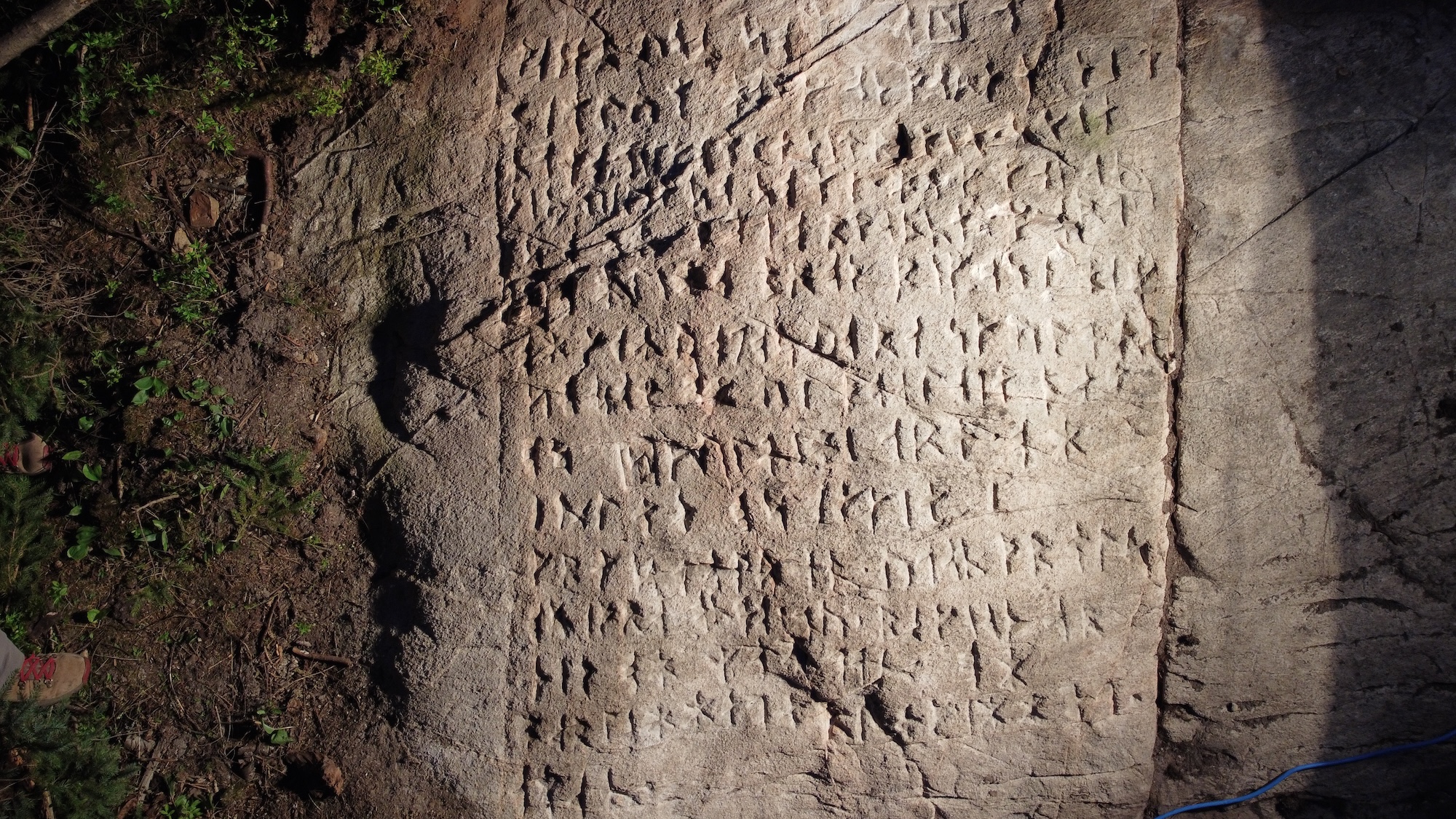
Get the Popular Science daily newsletter💡
Breakthroughs, discoveries, and DIY tips sent every weekday.
Archaeologists remain baffled by a surprising, seemingly ahistorical find located deep in the Canadian wilderness. But after years of research, analysis, and historical corroboration, an interdisciplinary team has finally made their findings available to the public. Tucked away in a forest approximately 465 miles northwest of Ottawa, a massive slab of bedrock features a hand-etched rendition of the full Lord’s Prayer. But the religious text isn’t inscribed in French or English—it’s composed of over 250 symbols from the oldest known runic alphabet.
The perplexing discovery happened completely by chance, according to the CBC. Hidden for centuries, the stone became exposed only after a tree fell near the town of Wawa, not far from Lake Superior. Closer inspection showed that someone had etched 255 runes into a roughly 4 by 5 foot section of the slab. Additionally, they took time to add a detailed illustration of a boat, an additional 16 runic signs, and 14 X markings.
Photos of the site soon wound up in front of Ryan Primrose, president of the Ontario Center for Archaeological Education, who was immediately stunned by the images.
“It’s certainly among the least expected discoveries of my career. It’s absolutely fascinating,” he told CBC.

Futhark runes
However, Primrose didn’t want anyone jumping to conclusions about the inscription. While it’s true that Vikings explored portions of present-day Canada thousands of years ago, he doubted they were responsible for the mystery message.
“We didn’t want to release anything publicly until we had done as much analysis as possible,” said Primrose.
He soon contacted Uppsala University emeritus professor of runology Henrik Williams, and helped the renowned expert arrange a visit to the site the following October.
“I was under a tarpaulin for three hours with a flashlight, looking at the runes and the others were sitting outside freezing,” recalled Williams.

The group’s patience and endurance paid off. Williams eventually determined that the message was written with Futhark alphabetic runes. First developed and used by Germanic peoples between the 2nd and 8th centuries CE, Futhark eventually evolved into a simplified version adopted by Scandinavians. Both the Anglo-Saxons and Frisiacs also expanded it into their own variants, but the knowledge of how to read its original iteration died out by the High Middle Ages (around 1000-1300 CE). It wouldn’t be until 1865 that Norwegian scholar Sophus Bugge finally succeeded in deciphering the long-lost language.
People across Europe remained fascinated with runes in the interim, however. During the early 1600s, Swedish polymath (and occultist) Johannes Bureus adopted the symbols into a system that roughly corresponded to his home country’s language. This culminated in the publication of a Swedish language Lord’s Prayer written with the Futhark runes in 1611. But don’t think the Canadian oddity’s story ended there.

A more recent inscription
“This must have been a Swede,” Primrose said of the etcher. “Were there any Swedes at all here?”
Not during the 17th century, according to his research. That said, historical documents confirm that Hudson’s Bay Company stationed Swedish workers at trading posts across Canada beginning in the 1800s. And it just so happens that Bureus’ runic Lord’s Prayer was republished during the 19th century.
Taken altogether, Primrose and colleagues now theorize that a Hudson’s Bay Company employee—or employees—are responsible for the labor-intensive project that likely took days, if not weeks to complete.
The conservationists are now working with the local landowners on a leasehold to turn their archaeological discovery into a public heritage site that includes a protective structure to guard it against the elements.
Primrose confessed to being “a little disappointed” that the artifact is likely only a couple centuries old, but plenty of questions still surround the find. Was the site a place for religious gatherings, or the devotional effort of one person? Prior to its exposure, the bedrock also lay under multiple inches of soil. With no other artifacts found nearby, was the prayer intentionally buried?
“The mystery doesn’t fade just because it’s younger than we hoped. Why was it carved here? Why this text? There are no answers,” he said. “And mysteries always draw people in.”

More deals, reviews, and buying guides
The PopSci team has tested hundreds of products and spent thousands of hours trying to find the best gear and gadgets you can buy.
























